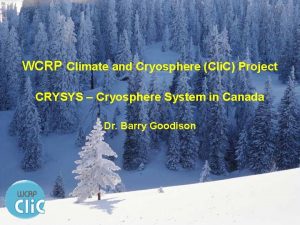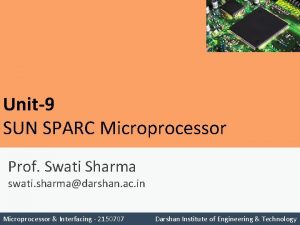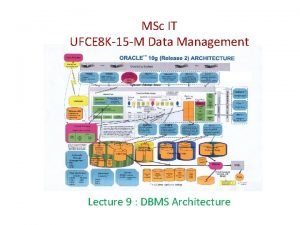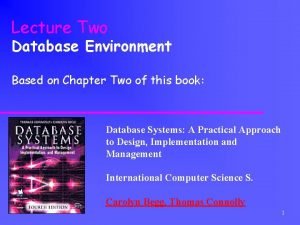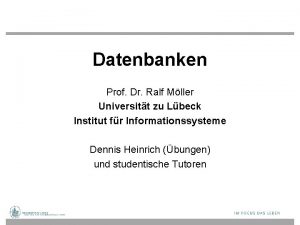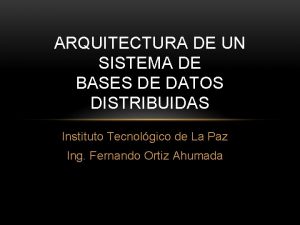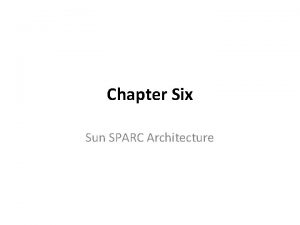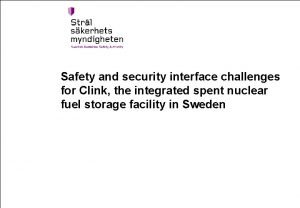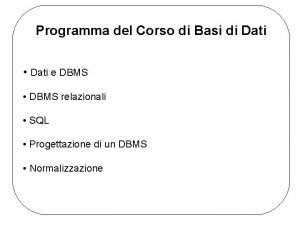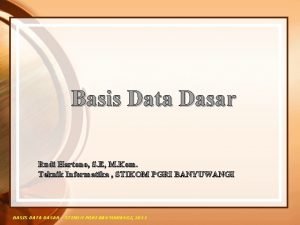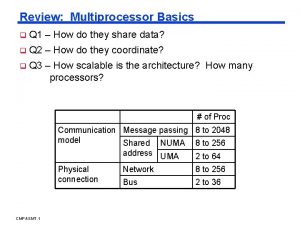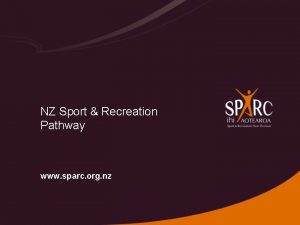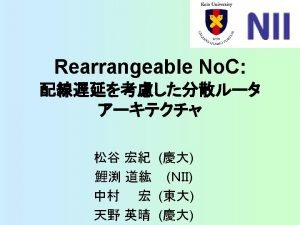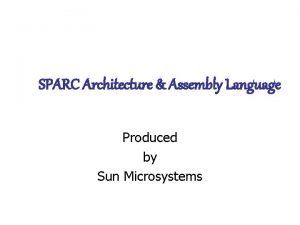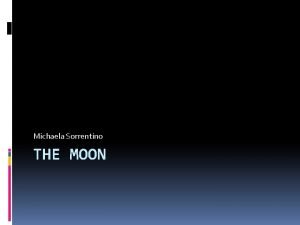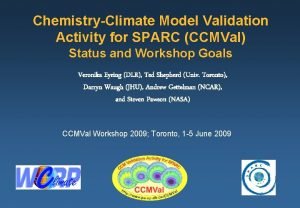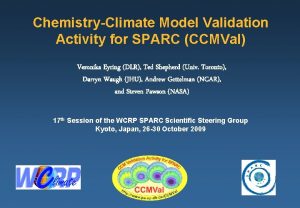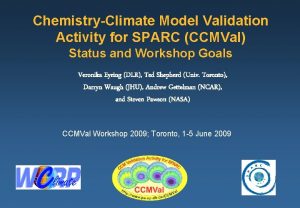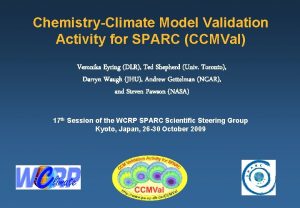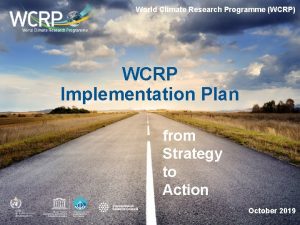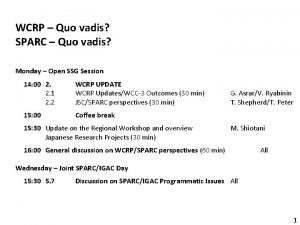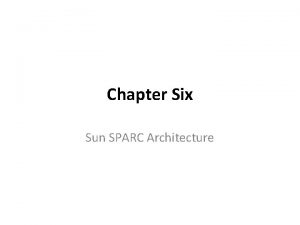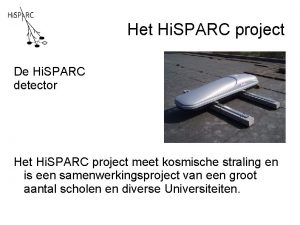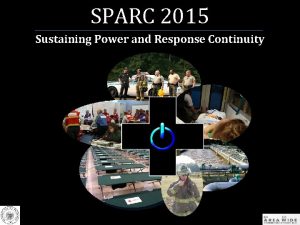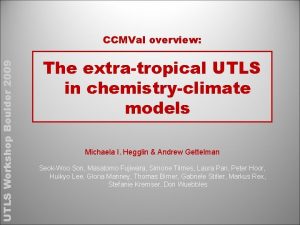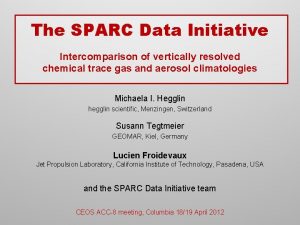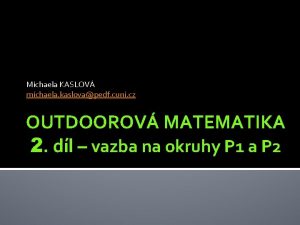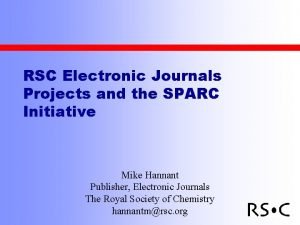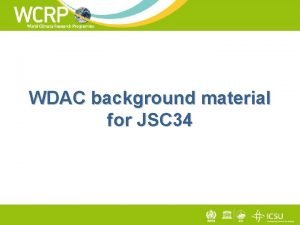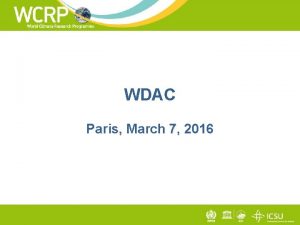WCRP SPARC CCMVal Data Initiative Michaela I Hegglin






















- Slides: 22

WCRP / SPARC CCMVal Data Initiative Michaela I. Hegglin University of Toronto, Canada

What is SPARC? SPARC - Stratospheric Processes And their Role in Climate • A core project of the World Climate Research Programme (WCRP) • Objective: engage and facilitate the stratospheric research community to focus on gaps in knowledge of particular relevance for climate, in coordination with relevant partners • Organization: Scientific Steering Group (SSG) and SPARC International Project Office (Toronto) • Themes: Climate-Chemistry Interactions Detection, Attribution, and Prediction of Stratospheric Change Stratosphere-Troposphere Dynamical Coupling • Several activities e. g. , CCMVal, Gravity Waves • SPARC reports, newsletters, meetings • SPARC Data Center • http: //www. atmosp. physics. utoronto. ca/SPARC/index. html

Data initiative

CCMVal (Chemistry-Climate Model Validation project) • Model-measurement inter-comparison of coupled chemistry-climate models (CCMs) using process-oriented diagnostics. • The different diagnostics test the representation of dynamics, chemistry, transport, radiation, and microphysics and are derived from robust diagnostic relationships found in observations. • The comparison between present-day observations and models aims at increasing our confidence in model predictions of ozone recovery and the interactions between stratospheric ozone and climate. • • 18 international models participated in this second round of CCMVal. Results will be available soon in the SPARC CCMVal report and a special issue in JGR, and are being used for the 2010 WMO/UNEP Ozone Assessment.

A first attempt at quantitative performance metrics • • Grading table: dark blue indicates good, white bad model performance The fidelity of the grading relies on the accuracy of the observations! • Chemical observations for CCMVal-1 mostly from HALOE. • CH 4 diagnostic in the SH polar region: even the best performing models do a bad job. • Indication that the quality of the observation may be questionable? Waugh and Eyring, 2008

Diagnostics and observations used in CCMVal-2 • CCMVal-2 attempted to include a larger set of diagnostics to test the models even more comprehensively. • CCMVal-2 included for the first time the comprehensive validation of CCM performance in the upper troposphere/lower stratosphere, of radiation and chemistry. • Also, more observations have been available for the comparisons. For chemical observations MLS, MIPAS, and ACE-FTS data have been used extensively in addition to HALOE. • Major efforts were needed in order to find and process suitable observations for comparison, establish robust diagnostics for the CCMs (which operate in a freerunning mode and are multi-dimensional).

Chemistry chapter: Diagnostics testing precursors and radicals Chipperfield and Kinnison, 2010 Grading of model performance in simulating precursors and radicals on the basis of ACE-FTS observations during two different time periods. Models performing best exhibit a more sophisticated chemistry scheme: AMTRAC, CMAM, EMAC, GEOSCCM, UMSLIMCAT, and WACCM.

UTLS chapter: Seasonal cycles in chemical trace gas species at different pressure levels Seasonal cycle of H 2 O 40°N-60°N: models coloured, MIPAS observations in black, ACE-FTS in grey • MIPAS shows likely a too low amplitude at 200 h. Pa (pers. communication G. Stiller, IMK, Karlsruhe) • ACE-FTS, despite potentially higher accuracy, shows very large std deviations, largely due to its highly restricted sampling. • Comparison between models and the two data sets yield different conclusions. Gettelman and Hegglin, 2010

CCMVal key findings • Comprehensive process-oriented validation against observations has led to a much better understanding of the strengths and weaknesses of CCMs. • • Quantifiable improvements have been achieved since CCMVal-1. • Nevertheless, some unphysical behaviour (e. g. dehydration properties) could be identified. • The process of assembling data sets for the comparisons revealed shortcomings in observational data sets and needs for future observations. Radiation and chemistry is sufficiently well represented in most models. Model performance in the UTLS was found to be better than might have been expected based on the spatial resolution of the models.

CCMVal Executive Summary key recommendations • Long-term vertically resolved data sets of constituent observations in the stratosphere are required to assess model behaviour and test model predictions. This includes ozone, but also other species that can be used to diagnose transport and chemistry. The current set of GCOS Essential Climate Variables is not sufficient for process-oriented validation of CCMs. • More global vertically resolved observations are required, particularly in the UTLS. As CCMs evolve towards including tropospheric chemistry, lack of observations in this region will become a major limitation on model validation. • A systematic comparison of existing observations is required in order to underpin future model evaluation efforts, by providing a more accurate assessment of measurement uncertainties. Need for an assessment of the available data sets for chemical trace gases (analogous to SPARC Report No. 3 for the meteorological data sets)

SPARC Data Initiative The proposed SPARC Report will offer guidance for the use of chemical trace gas observations from space-based instruments. Compile climatologies of chemical trace gases (e. g. zonal means, variability, seasonal evolution, annual means) in collaboration with the instrument PIs. Inter-compare the climatologies, summarizing useful information and identifying differences between the data sets. Establish a data portal for chemical observations in collaboration with the space agencies and assessing state of data availability.

Scope Vertically resolved measurements of chemical trace gas species from the upper troposphere to the middle mesosphere (approximately 5 -65 km). The main focus is on satellite measurements but, where helpful, the evaluation may be enhanced through aircraft and balloon measurements. The main species the report is targeted at are CH 4, N 2 O, HNO 3, NOy, NOx, NO 2, HCl, Cly, Bry, age of air (SF 6 and CO 2). Ozone and water vapor may also be treated briefly, heavily drawing on the SPARC water vapor and ozone initiatives.

Timeliness • The initiative is very timely given the fact that the “golden age” of stratospheric composition measurements of the past three decades is about to come to an end, • it is highly likely that there will be much less measurements in the future, we need to capture existing knowledge on current and recent instruments before this knowledge is lost. In particular the report will also help to identify priorities for reprocessing data or enhanced validation efforts identify measurement gaps, which could motivate and provide support for future missions.

Satellite Measurements Satellite measurements: primary source of chemical data sets of the middle atmosphere during the last 30 years

Synergies • NASA MEa. SUREs - GOZCARDS program lead: Lucien Froidevaux homogenized stratospheric data sets for American missions • ESA Climate Change Initiative Reprocessing of data sets Identified Contacts • • • Author team: Michaela Hegglin & Susann Tegtmeier (co-leads), Samuel Brohede, Lucien Froidevaux, Bernd Funke, Jessica Neu, Erkki Kyrola, Alexei Rozanov, Joachim Urban, Thomas von Clarmann, Kaley Walker, John Anderson Space Agencies: NASA: Ken Jucks CSA: Thomas Piekutowski, Stella Melo ESA: Claus Zehner, Joerg Langen Experts / Advisory group Bill Randel, Karen Rosenlof, Greg Bodeker, Ted Shepherd

• Instrument Contacts: • • • MLS (Aura/UARS): Lucien Froidevaux, Michelle Santee, Nathaniel Livesey TES (Aura): Jessica Neu, John Worden ACE-FTS (SCISAT-1): Peter Bernath, Kaley Walker OSIRIS (Odin): Doug Degenstein SMR (Odin): Donal Murtagh, Samuel Brohede, Jo Urban HIRDLS: John Gille MIPAS (ENVISAT): Gabriele Stiller, Thomas von Clarmann SCIAMACHY (ENVISAT): John Burrows, Alexei Rozanov GOMOS: E. Kyröla, J. Tamminen HALOE (UARS): James M. Russell III, Ellis Remsberg, John Anderson ILAS I / II (ADEOS-1, 2): Tatsuya Yokota, Yasuhiro Sasano SAGE I / III: M. Patrick Mc. Cormick SME: Garry Rottman POAM II / III (SPOT-3, 4): Karl Hoppel SABER (TIMED): James M. Russell III AIM/SOFIE: James M. Russell III, Larry Godley

Time Line Author team defined by March 2010 Proposal submitted to ISSI for funding for initiative-related workshops • Report outline to be defined by July 2010 • Workshop I (autumn 2010) • Workshop II (autumn 2011) • SPARC Report to be completed by May 2012 How can CEOS help? • Encourage the relevant space agencies to provide financial support of people who participate in the Data Initiative and offer their work-time. • Help facilitate a web-based data portal through which we could make available the data sets we generate and use for the evaluations in the report. Can the Atmospheric Composition Portal serve this need?

Aircraft and Balloon Measurements Variety of aircraft and balloon campaigns available (list not complete): • provide high accuracy, high precision and high resolution data • limited sampling in time and space SPARC Newsletter No. 26 (2006)

For some atmospheric missions climatologies have been developed, e. g. • A stratospheric climatology for O 3, H 2 O, CH 4, NOx, HCl and HF derived from HALOE measurements (Grooß and Russell, ACP 2005). • Odin stratospheric proxy NOy measurements and climatology (Brohede et al. , ACP 2008). • Nitric acid in the stratosphere based on Odin observations from 2001 to 2009 – Part 1: A global climatology (Urban et al. , ACP, 2009). • Towards a climatology of stratospheric bromine monoxide from SCIAMACHY limb observations (Sheode et al. , ACPD 2006). • Technical Note: A new global database of trace gases and aerosols from multiple sources of high vertical resolution measurements (Hassler et al. , ACP, 2008). • Br. O climatology from OSIRIS (Mc. Linden). • A Stratospheric NO 2 Climatology from Odin/OSIRIS Limb-Scatter Measurements (Brohede at al. , Can. J. Phys. , 2007).

EVALUATIONS Zonal mean climatologies HALOE NOx climatology January (sunset only) 1991 - 2002 Grooß and Russell, ACP 2005 SCIAMACHY Br. O climatology December-February 2003 - 2004 Sheode et al. , ACPD 2006

EVALUATIONS Seasonal evolution Odin NOy climatology seasonal cycle of monthly mean values Odin NOy climatology seasonal cycle of standard deviation Brohede et al. , ACP 2008

EVALUATIONS Comparison of seasonal evolution Seasonal cycles derived from HALOE and SAGE II (sunset) data on the 375 K isentrope. The values are mixing ratios given in ppmv. WAVAS SPARC report n° 2, 2000
 Cryosphere
Cryosphere May-hegglin anomaly
May-hegglin anomaly Swati sun
Swati sun Ansi/sparc
Ansi/sparc Ansi/sparc
Ansi/sparc Konzeptionelles datenmodell beispiel
Konzeptionelles datenmodell beispiel Ansi sparc
Ansi sparc Arquitectura de un sistema de base de datos
Arquitectura de un sistema de base de datos Oracle cloud sparc
Oracle cloud sparc Sun sparc architecture
Sun sparc architecture Quizzes
Quizzes Clab sparc
Clab sparc Architettura ansi sparc
Architettura ansi sparc Arsitektur database
Arsitektur database Sparc
Sparc Sparc nz
Sparc nz Sparc
Sparc Oracle sun
Oracle sun Sun sparc architecture
Sun sparc architecture Michaela salmon
Michaela salmon Michaela porubanova
Michaela porubanova Michaelah moon
Michaelah moon Michaela srnk
Michaela srnk
